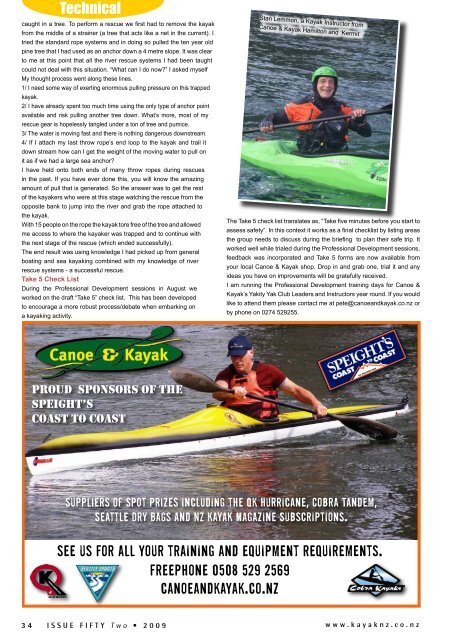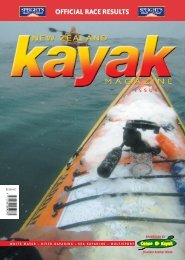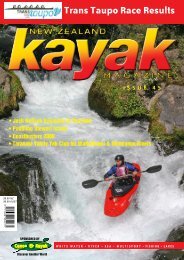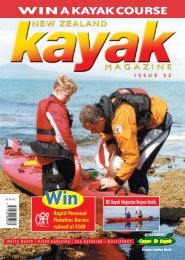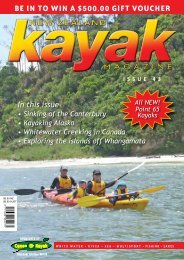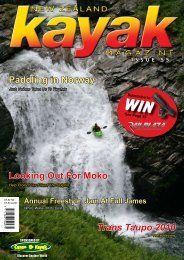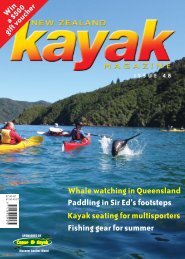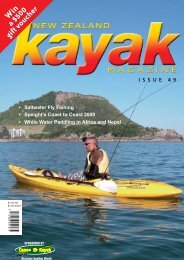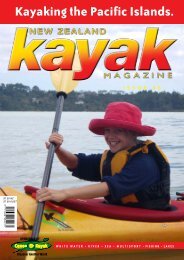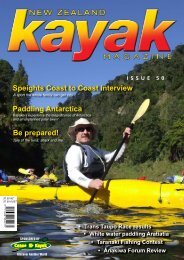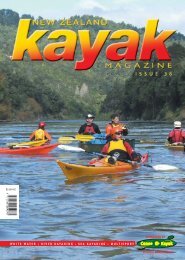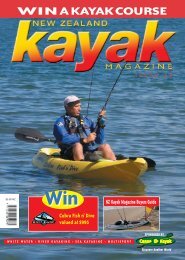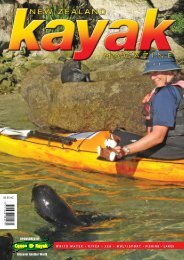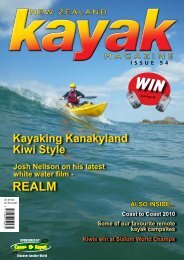Wasps, Wakas & Wallabies Nepal Update Getting ... - Canoe & Kayak
Wasps, Wakas & Wallabies Nepal Update Getting ... - Canoe & Kayak
Wasps, Wakas & Wallabies Nepal Update Getting ... - Canoe & Kayak
You also want an ePaper? Increase the reach of your titles
YUMPU automatically turns print PDFs into web optimized ePapers that Google loves.
Technical<br />
caught in a tree. To perform a rescue we first had to remove the kayak<br />
from the middle of a strainer (a tree that acts like a net in the current). I<br />
tried the standard rope systems and in doing so pulled the ten year old<br />
pine tree that I had used as an anchor down a 4 metre slope. It was clear<br />
to me at this point that all the river rescue systems I had been taught<br />
could not deal with this situation. “What can I do now?” I asked myself<br />
My thought process went along these lines.<br />
1/ I need some way of exerting enormous pulling pressure on this trapped<br />
kayak.<br />
2/ I have already spent too much time using the only type of anchor point<br />
available and risk pulling another tree down. What’s more, most of my<br />
rescue gear is hopelessly tangled under a ton of tree and pumice.<br />
3/ The water is moving fast and there is nothing dangerous downstream.<br />
4/ If I attach my last throw rope’s end loop to the kayak and trail it<br />
down stream how can I get the weight of the moving water to pull on<br />
it as if we had a large sea anchor?<br />
I have held onto both ends of many throw ropes during rescues<br />
in the past. If you have ever done this, you will know the amazing<br />
amount of pull that is generated. So the answer was to get the rest<br />
of the kayakers who were at this stage watching the rescue from the<br />
opposite bank to jump into the river and grab the rope attached to<br />
the kayak.<br />
With 15 people on the rope the kayak tore free of the tree and allowed<br />
me access to where the kayaker was trapped and to continue with<br />
the next stage of the rescue (which ended successfully).<br />
The end result was using knowledge I had picked up from general<br />
boating and sea kayaking combined with my knowledge of river<br />
rescue systems - a successful rescue.<br />
Take 5 Check List<br />
During the Professional Development sessions in August we<br />
worked on the draft “Take 5” check list. This has been developed<br />
to encourage a more robust process/debate when embarking on<br />
a kayaking activity.<br />
Stan Lemmon, a <strong>Kayak</strong> Instructor from<br />
<strong>Canoe</strong> & <strong>Kayak</strong> Hamilton and ‘Kermit’<br />
The Take 5 check list translates as, “Take five minutes before you start to<br />
assess safety”. In this context it works as a final checklist by listing areas<br />
the group needs to discuss during the briefing to plan their safe trip. It<br />
worked well while trialed during the Professional Development sessions,<br />
feedback was incorporated and Take 5 forms are now available from<br />
your local <strong>Canoe</strong> & <strong>Kayak</strong> shop. Drop in and grab one, trial it and any<br />
ideas you have on improvements will be gratefully received.<br />
I am running the Professional Development training days for <strong>Canoe</strong> &<br />
<strong>Kayak</strong>’s Yakity Yak Club Leaders and Instructors year round. If you would<br />
like to attend them please contact me at pete@canoeandkayak.co.nz or<br />
by phone on 0274 529255.<br />
proud sponsors of the<br />
speight’s<br />
coast to coast<br />
suppliers of spot prizes including the QK Hurricane, Cobra Tandem,<br />
Seattle Dry Bags and NZ <strong>Kayak</strong> Magazine Subscriptions.<br />
see us for all your training and equipment requirements.<br />
freephone 0508 529 2569<br />
canoeandkayak.co.nz<br />
34 ISSUE FIFTY Two • 2 0 0 9<br />
www.kayaknz.co.nz


